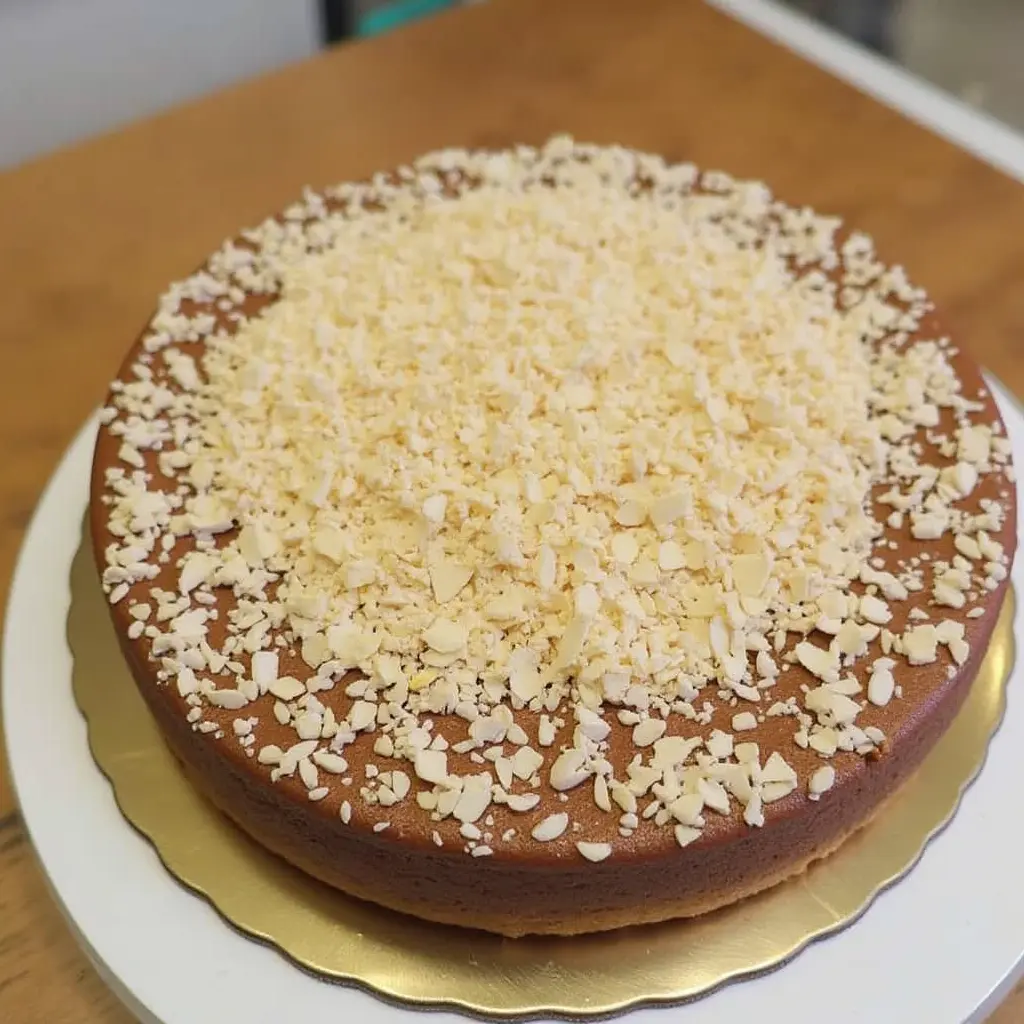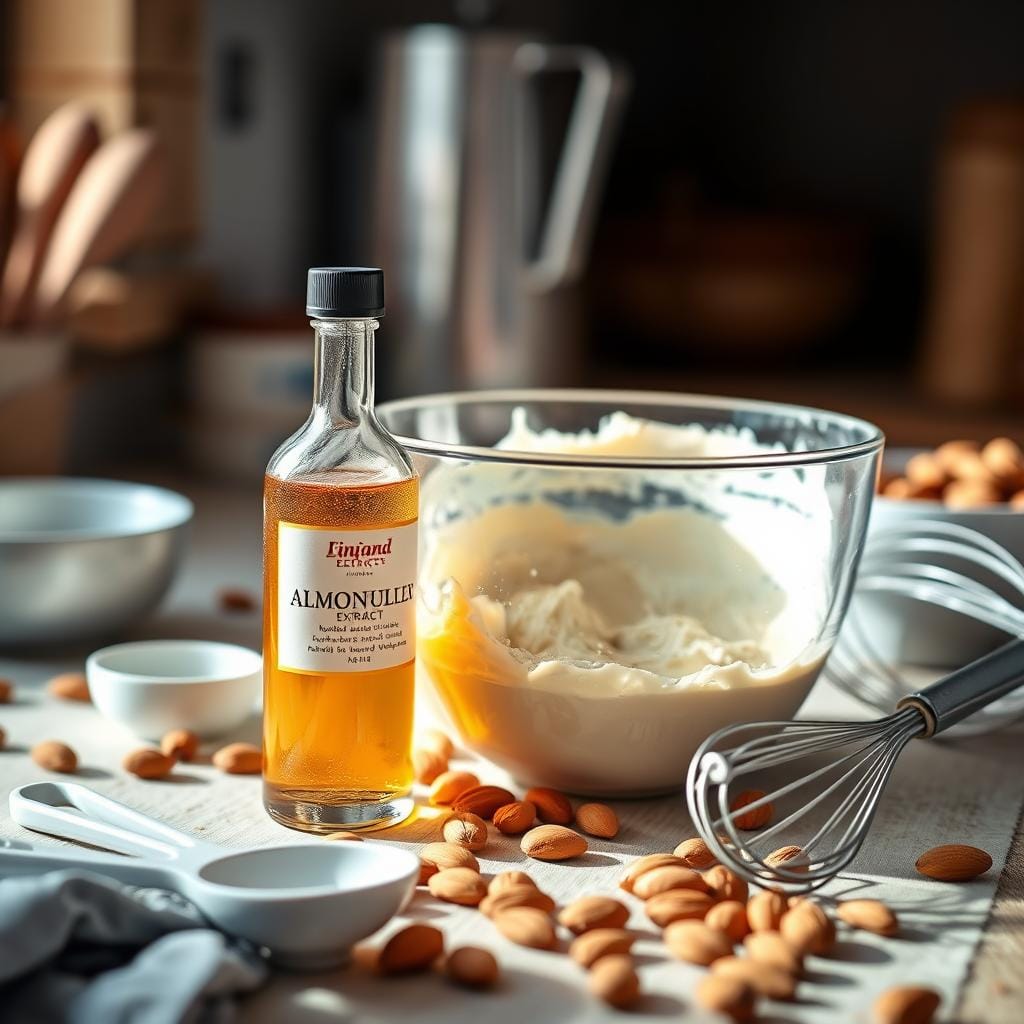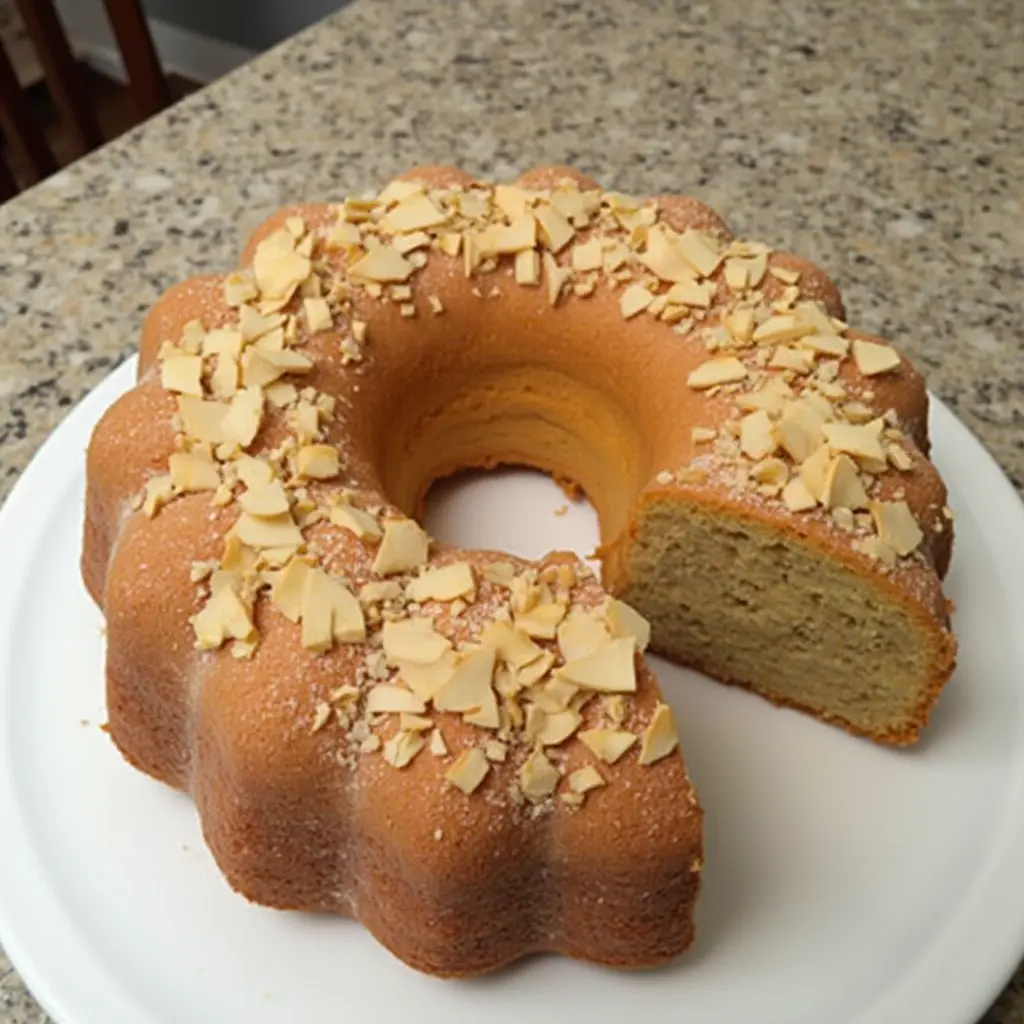What does almond extract do to a cake? Every baker cherishes the moment when a simple ingredient transforms an ordinary cake. Almond extract is that secret weapon—a tiny bottle delivering big flavor. The first time I used it, my grandmother’s vanilla cake became unforgettable.
Baking with almond extract is more than adding flavor—it’s about creating an experience. This ingredient can make your cakes unforgettable. Whether you’re a pro or a weekend baker, knowing how to use almond extract can boost your skills.
Cakes with almond extract have a unique depth. They turn simple recipes into gourmet treats. Its intense, nutty flavor can make a simple sponge cake into a sophisticated dessert that delights your taste buds.

Key Takeaways
- Almond extract provides intense, concentrated flavor
- A little extract goes a long way in baking
- Enhances both sweet and subtle cake recipes
- Adds complexity to traditional cake flavors
- Works brilliantly with multiple baking styles
Understanding Almond Extract in Baking
Almond extract adds a rich, nutty flavor to baked goods. It’s great for both professional bakers and home cooks. Knowing how to use almond extract can make your dishes stand out.

Natural vs. Artificial Almond Extract
There are two main types of almond extract:
- Natural Almond Extract: Made from bitter almonds, it has a deep, real flavor
- Artificial Almond Extract: Made from chemicals, it’s cheaper but still tasty
“The quality of your almond extract can make or break your baked goods.” – Professional Pastry Chef
Chemical Composition of Almond Extract
Benzaldehyde is the key to almond extract’s taste. This organic compound gives baked goods that unique almond flavor.
History of Almond Flavoring in Pastries
Almond extract has been used for centuries in baking. It adds depth and complexity to desserts. From Europe to America, it’s a secret ingredient in many treats.
Remember, a little almond extract goes a long way. Just a few drops can turn a simple cake into a special dessert.
What Does Almond Extract Do to a Cake?
Almond extract makes ordinary cakes into something special. It adds a unique flavor that changes how your cake tastes and smells. This extract gives a deep, nutty flavor that regular almonds can’t match.

Almond extract is known for its strong flavor. Just a few drops can make your cake taste like almonds in a way regular almonds can’t. Bakers use it to add depth to their desserts.
- Intensifies cake’s overall flavor profile
- Adds subtle nutty undertones
- Enhances aroma dramatically
- Creates a more sophisticated taste experience
Almond extract works differently with different cakes. Vanilla-based cakes and white cakes get a special flavor from it. It blends with other ingredients to create a unique taste that’s both familiar and exotic.
“A few drops of almond extract can transform an ordinary cake into a gourmet dessert” – Professional Pastry Chef
The amount of almond extract you use changes the cake’s flavor. A little gives a soft hint, while more makes the almond taste strong.
| Cake Type | Almond Extract Impact | Recommended Quantity |
|---|---|---|
| White Cake | Subtle Enhancement | 1/2 to 1 teaspoon |
| Pound Cake | Rich Flavor Boost | 1 to 1.5 teaspoons |
| Sponge Cake | Delicate Aromatics | 1/4 to 1/2 teaspoon |
Knowing how almond extract affects cakes helps you make better desserts. It’s great for adding a hint or making a bold flavor statement. This ingredient is very versatile in baking.
The Science Behind Almond Extract’s Flavor Enhancement
Baking with almond extract is a delicate art. It involves complex molecular interactions and precise flavor development. Knowing the science behind almond extract can make your baked goods truly special.
Molecular Interactions in Baking
Almond extract flavor comes from chemical reactions in baking. The main compound, benzaldehyde, mixes with other ingredients. This creates a rich, nuanced taste.
These molecular interactions occur at different baking stages:
- Initial mixing creates flavor potential
- Heat activation releases aromatic compounds
- Protein and sugar interactions enhance complexity
Temperature’s Role in Flavor Development
Temperature is key in baking with almond extract. As your cake bakes, heat triggers chemical changes. These changes unlock the extract’s full flavor.
| Temperature Range | Flavor Impact |
|---|---|
| 100-250°F | Initial flavor release |
| 250-350°F | Peak aromatic complexity |
| 350-400°F | Potential flavor degradation |
Flavor Transformation During Baking
The baking process is a journey of flavor evolution. Almond extract’s volatile compounds interact with cake ingredients. This creates a sophisticated taste experience.
“Baking is a science, and almond extract is your delicious research partner.” – Professional Pastry Chef
By understanding these scientific principles, you can master baking with almond extract. This ensures consistently delightful results.
Proper Measurements and Usage Guidelines
When baking with almond extract, precision is key. It makes your desserts truly special. Professional bakers say a little goes a long way with this flavor.
“Almond extract is like a secret weapon in baking – use it wisely, and it can elevate your entire recipe.” – Pastry Chef Sarah Martinez
For most cake recipes, follow these essential guidelines when using almond extract:
- Standard 9-inch cake: Use 1/2 to 1 teaspoon of almond extract
- Cupcakes (12 count): Add 1/4 to 1/2 teaspoon
- Bundt cake: Incorporate 3/4 to 1 teaspoon
- Delicate pastries: Start with just 1/4 teaspoon
Mastering almond extract uses means understanding its strong flavor. Too much can overpower, while too little might make it bland. Always add the extract gradually, tasting as you go.
Professional baking tips for almond extract include:
- Measure precisely using standard measuring spoons
- Mix extract thoroughly into wet ingredients
- Taste batter before baking to adjust flavor
- Store extract in a cool, dark place
Different types of almond extract (natural or artificial) might need slight adjustments. Natural almond extract is often more potent, so you might need less.
Pro tip: When experimenting with almond extract recipes, start conservative and build flavor complexity gradually.
Impact on Cake Texture and Moisture
Exploring cakes with almond extract reveals its amazing power. It does more than just add flavor. It changes the cake’s texture and how moist it stays.
Bakers love almond extract for its special qualities. It does more than just taste good. It makes cakes in unique ways.
Effects on Crumb Structure
Almond extract changes how flour proteins work. This leads to a softer, more even crumb. It breaks down gluten strands, making the cake:
- Softer
- More even
- Lighter
Moisture Retention Properties
Almond extract’s magic is in keeping moisture in. It stops water from evaporating while baking. This means:
- Cakes stay tender longer
- Less chance of dryness
- Baked goods last longer
Changes in Cake Density
Almond extract also affects cake density. It creates tiny air pockets during mixing. This makes the cake lighter and keeps it firm.
“The secret to a perfect cake isn’t just ingredients, but understanding how they interact.” – Professional Baker
Knowing these effects lets you use almond extract to make your baking better.
Combining Almond Extract with Other Flavors
Almond extract can make your cakes taste amazing by mixing it with other flavors. Learning how to mix it can turn simple desserts into something special.
Some flavors go great with almond extract. Here are a few classic pairings to try in your recipes:
- Chocolate and Almond: A rich, decadent mix that boosts both flavors
- Vanilla and Almond: Smooth, complementary notes that add depth
- Fruit and Almond: Cherry, raspberry, and peach pair well with almond’s nutty taste
Experts say to use almond extract carefully. A little goes a long way in changing a cake’s taste. Start with a small amount and adjust to taste.
“Almond extract is like a secret weapon in baking – use it wisely, and it can elevate your desserts from good to unforgettable.” – Professional Pastry Chef
Being creative is important when mixing almond extract with other flavors. Try new things and find unique tastes that will wow your guests.
Common Mistakes When Using Almond Extract
Baking with almond extract can make ordinary desserts special. But, many bakers face challenges with this strong flavor. Knowing the common mistakes helps you make delicious treats every time.
When using almond extract, knowing is key. Let’s look at the most common mistakes and how to avoid them.
Avoiding Over-Flavoring Disasters
Almond extract can overpower if not used right. Here are a few tips to avoid flavor mishaps:
- Start with small amounts – typically 1/4 to 1/2 teaspoon per recipe
- Taste test your batter before baking
- Remember that almond extract is much stronger than vanilla
Smart Storage Strategies
Storing almond extract right keeps its flavor strong. Follow these tips:
- Store in a cool, dark place
- Keep the bottle tightly sealed
- Check the expiration date regularly
“Precision is the secret to perfect baking” – Professional Pastry Chef
Quality Control Recommendations
Not all almond extracts are the same. Choose high-quality brands with pure, natural ingredients. Cheap, artificial versions might save money but can ruin your baking.
With these tips, you’ll get better at using almond extract. Your baking will reach new heights.
Best Types of Cakes for Almond Extract
Almond extract can turn simple cakes into amazing treats. Not all cakes are the same when it comes to almond extract. Some really stand out, making desserts that are unforgettable.
Looking into almond extract recipes, some cakes are better than others. Here are a few that really show off the flavor:
- Pound Cakes: Their dense texture goes well with almond extract
- Bundt Cakes: Their shape helps the flavor spread evenly
- Sponge Cakes: Their lightness lets the almond extract shine
- Coffee Cakes: They have a nutty taste that matches almond extract well
“The secret to an unforgettable cake lies in understanding how almond extract interacts with different ingredients.” – Professional Baker
Choosing the right cake is key to success. Some classic pairings include:
| Cake Type | Recommended Almond Extract Usage | Flavor Profile |
|---|---|---|
| Classic White Cake | 1/2 to 1 teaspoon | Delicate, subtle almond essence |
| Chocolate Cake | 1 teaspoon | Rich, intense nutty undertones |
| Fruit Cake | 3/4 teaspoon | Complementary warm notes |
Trying almond extract in various cakes can lead to new tastes. Start with a small amount and adjust to taste.
Expert Tips for Maximum Flavor Impact
Mastering baking with almond extract takes skill and precision. Professional bakers know it can turn a simple cake into a masterpiece. By using the right techniques, you can make your baking better and bring out the almond extract’s flavor.
To get the most out of almond extract, consider a few key factors. These expert tips will help you achieve amazing results in your baking.
Strategic Timing of Extract Addition
When you add almond extract can change how your cake tastes. Here are some tips to keep in mind:
- Add extract during initial mixing stages for uniform distribution
- Incorporate into wet ingredients for better absorption
- Avoid adding extract to extremely hot mixtures to prevent flavor degradation
Temperature Precision
Temperature is important when using almond extract. High heat can ruin the delicate flavors. So, keep the temperature moderate.
- Mix extract at room temperature
- Use gentle heating techniques
- Avoid direct high-heat exposure
Advanced Mixing Techniques
Good mixing is key to enjoying the almond extract’s benefits. Professional bakers suggest:
- Gentle folding to preserve flavor intensity
- Using a whisk for even distribution
- Avoiding overmixing which can compromise texture
“Precision is the secret ingredient in transforming a good cake into an extraordinary culinary masterpiece.” – Professional Pastry Chef
By following these expert tips, you’ll unlock the full potential of almond extract. Your desserts will be unforgettable and a delight to the senses.
Conclusion
Discovering almond extract’s magic can make your cake baking amazing. It brings a sophisticated flavor that makes simple recipes shine. Whether you bake at home or professionally, knowing how almond extract works can open up new possibilities in your kitchen.
Exploring almond extract shows its incredible versatility. Your baking will grow as you try new things with this powerful ingredient. It’s not just about taste; it also adds moisture and complexity to your desserts.
Mastering almond extract is about being precise and creative. Start with a little, taste often, and adjust recipes as you like. Each cake is a chance to show off your skills, with almond extract as your secret ingredient.
With this knowledge, you’ll make desserts that amaze and impress. From light sponge cakes to dense pound cakes, almond extract opens up a world of flavors. Trust your taste and let your creativity shine in the kitchen.

